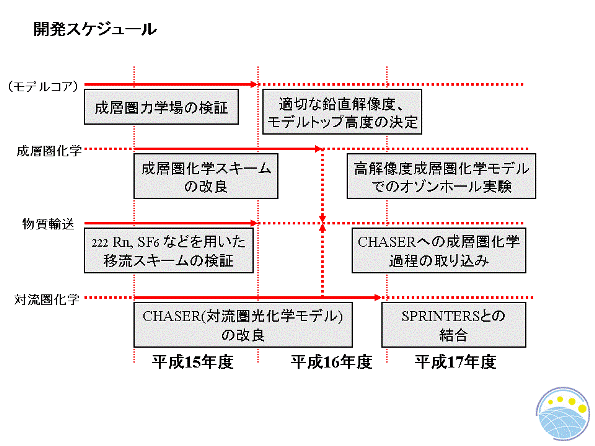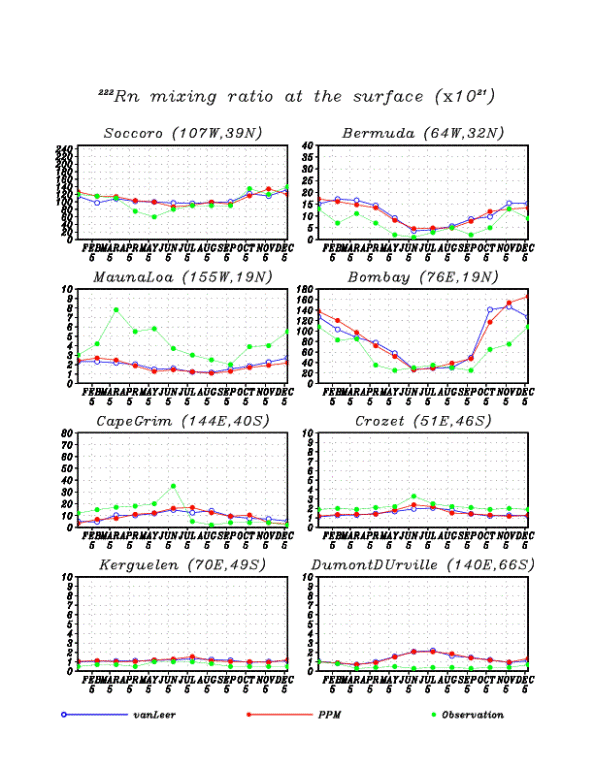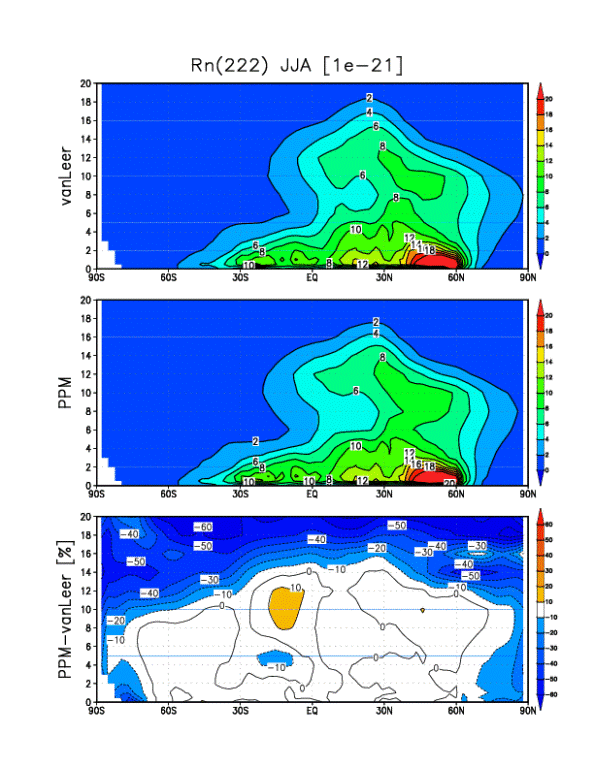2. Warming and atmospheric composition change interaction model developmentResults Page | Top Page |
||||||
|
2-1 Warming and atmospheric composition change interaction model The organization in charge: Earth frontier research system
a. SummaryTroposhere ozone has the important role that itself not only affects global warming, but controls the photochemistry-life of warming gas, such as carbon dioxide and methane, through change of OH radical etc. While this subgroup estimates quantitatively the interaction of the troposhere and stratosphere ozone, and a climate change using the general circulation model explicitly combined with the chemical process, in an integrated model, it is due to take into consideration also about an interaction with other sub model, such as a surface-of-the-earth vegetation model, and a chemical oceanography model, an aerosol model. In FY 2002, a numerical simulation about introduction of the high precision substance advection current scheme in a general circulation model, and warming and the atmospheric composition change interaction using a troposhere chemical-bond general circulation model was first done as the start. It has checked that the overestimation tendency of the substance concentration in the up troposhere of a model was improved by the high precision advection current scheme. Moreover, as a result of conducting the future prediction experiment using a troposhere photochemistry joint general circulation model, it turned out that the concentration of the methane which is main warming origin substances, and sulfuric-acid aerosol is greatly influenced by a climate change and change of a water vapour content. b. Research purposeThe ozone in the atmosphere is bearing the important role in the dynamic meaning and the environmental study-meaning. Moreover, itself is not only important for global warming or global environment problems, but chemical substances, such as steam, OH radicalness and NOx, and carbon monoxide, can have great influence on other warming gas, such as sulfuric-acid aerosol and methane, besides ozone. For this reason, it is thought that it is important to conduct a warming prediction experiment using the model in consideration of an interaction with atmospheric chemistry after that elaboration, quantification, and warming process of a forecast understand. c. A research program, a method, a scheduleIn the University of Tokyo climate center, the environmental-research center, and the earth frontier research system, the general circulation model explicitly combined with photochemical reaction process was developed, and impact evaluation (Sudo et al., 2001) to the future prediction experiment (Nagashima et al., 2002) of a stratosphere ozone hole, the estimate (Takigawa et al., 2002) of stratosphere sulfur income and outgo, and the troposhere ozone of ENSO etc. has so far been studied. In this symbiosis project, it extends to the general circulation model combined with the photochemical processes of the stratosphere and the troposhere based on the model (CHASER, cf.Sudo et al., 2002a, 2002b) which incorporated the troposhere photochemistry model in detail, and the Earth Simulator is used and high resolution time slice simulation based on the emission scenario of shoes is performed. The point of fixation in this time is change of OH radical mainly produced as a result of [ its ] the steam change by a climate change, and influence which it has on the photochemistry-life of methane in the troposhere. In the stratosphere, it is the interaction of the ozone destruction effect activated by the heterogeneous reaction on change of the stratosphere water vapour content by a climate change, a polar stratosphere cloud, and its surface. Since it unites and cumulus convection activity is changed by a climate change, I think that he wants to evaluate also about change of the amount of thunder NOx generation which occurs in that case. Next, after incorporating the stratosphere aerosol of the dust winding-up process of the troposhere aerosol model SPRINTARS developed by the University of Tokyo climate center and the Kyushu University applied mechanics research institute , and a stratosphere chemical-bond model (Nagashima et al., 2002) and extending CHASER to an aerosol - chemistry - climate model, impact evaluation to the aerosol of a chemical process is performed. Sulfuric-acid aerosol has received big influence in the chemical process among troposhere aerosol. This is because precursor gases, such as sulfur dioxide emitted from surface of the earth, serve as sulfuric-acid aerosol by a reaction with the ozone in a vapor phase and a liquid phase, hydrogen peroxide, and OH radical. Moreover, the artificial origin emission of sulfur dioxide is considered to change a burst size sharply by a future Asian region, especially Chinese economic development, and is very important for considering the impact evaluation to the climate in detail in future warming research. After evaluating the interaction between each process which used these partial integrated models, construction of a final integrated model is begun. Besides an interaction which was described previously, it is possible to evaluate the influence on the ecosystem by discharge of the nonmethane hydrocarbon from a terrestrial ecosystem model and the acid rain conversely forecast from an atmospheric chemistry model, and the amount of ozone etc. Moreover, although it is said on the ocean that sulfuric-acid aerosol is important as a cloud condensation nucleus, I also think that he wants to examine predicting the burst size from the ocean of DMS as the source of generation to the atmosphere within a marine ecosystem model in the future. About cooperation with other symbiosis projects, it is due to carry out, taking cooperation to both both [ "advancements of an air oceanic circulation model" and ] about development and verification of a general circulation model. Into their group, since the interaction of various aerosol and a climate change is due to be taken into consideration in the case of a warming experiment, I think that he wants to further model development etc., staying in touch densely about verification of a substance transport process, aerosol generation process, etc. in an air model. Moreover, about the chemical process, it is planning comparing and verifying the observation result of the carbon monoxide obtained by "an advancement of parameterization of many physics process" by the University of Tokyo, an earth frontier research system, etc., and the calculation result obtained by this model. Moreover, it considers receiving offer also about the emission scenario from the surface of the earth of the chemical substance at the time of a warming experiment.
d. The research program in FY 2002In order to evaluate the influence of the chemical substance in the atmosphere in detail, it is required to express appropriately transportation of a chemical substance and the chemical reaction in the stratosphere and the troposhere within a model first. For this reason, this fiscal year performs improvement and evaluation of these two process in the start of a symbiosis project. e. Reports in FY 2002(a) Material recyclingIn order to investigate the situation of substance transportation in the stratosphere and the troposhere in CCSR/NIES AGCM, the Earth Simulator etc. was used and the transportation experiment of passive tracers, such as radon and 6 sulfur fluorides, was conducted. It adds to these this time and these passive tracers are Age-of-Air tr of Lin and Williamson (2000), although generally used to mutual comparison of transportation between models by TRANSCOM etc. acer is also taken into consideration. This is an imagination tracer for investigating the age of air mass in the stratosphere, and by combining with the model result, observation result, etc. of 6 sulfur fluorides, although the situation of the stratosphere and troposhere material recycling in this model is evaluated, it is useful. In this experiment, horizontal resolution was made into x2.8 degree and perpendicular resolution was made into 67 layers from surface of the earth to the altitude of about 80km whenever [ about 2.8 ]. Calculation was respectively performed for two years after the spin up for four years using two kinds of advection current schemes, monotonic van Leer and monotonic ppm (Piecewise Parabolic Method) with steepening. For this reason, for material recycling of the stratosphere, it analyzed about material recycling in the troposhere, especially radon-222 this time for about several years. The seasonal variation of the radon-222 in surface of the earth is shown in Fig. 2. About distribution of the radon-222 in surface of the earth, when which of two kinds of advection current schemes is used, it turns out that there is no big change. Moreover, the model is often reproducing the seasonal variation by Bombay, Bermuda, etc. Mauna length overall is a model although it is an observation point on Pacific Ocean. Since resolution power is low, an island part cannot fully be expressed, but the emission from surface of the earth is considered that the model has underestimated the concentration of the radon-222 which is the main sources of generation. Next, the latitude advanced sectional view of the radon-222 in a Northern Hemisphere summer which carried out the east-and-west average is shown in Fig. 3. Also when which advection current scheme is applied about the concentration near surface of the earth, there is no big change, but it turns out that the difference remarkable in the concentration in the domain distant distantly from the source of generation especially the domain which lasts to the lower stratosphere from the up troposhere, a two-poles region, etc. has appeared. When a van Leer advection current scheme is applied in a symbiosis first division title, it is known that it is in the tendency which overestimates specific humidity in the up troposhere, and it is the result of this experiment. monotonic ppm with steepening It has suggested that an advection current scheme improves this model bias.
(b) Troposhere chemistry The prediction experiment which used CHASER was conducted about how photochemical processes centering on troposhere ozone change towards the future (cf., Sudo, 2003). In this research, in order to take into consideration the effect of both emission change and the weather place change by a climate change, two kinds of experiments, the experiment (Exp1) of only emission change and the experiment (Exp2) which took the climate change into consideration in addition to emission change, were performed. In these experiments, both emission change and a climate change followed IPCC SRES-A2 scenario. In prediction of the climate change of Exp2, while making the greenhouse-effect gas concentration of CO2 grade increase in a model, the sea surface temperature and sea ice distribution which were predicted by the CCSR/NIES air sea joint model were given (this model has high climate sensitivity and needs cautions at prediction of a future climate change to be in the tendency which predicts a higher rise in temperature compared with other models). The troposhere ozone total amount increased almost linearly Exp1, and about 44% of increase was calculated in 23% and 2100 in 2050 (figure 4a). The one or more-Exp increase in ozone was calculated, and although the increase in ozone was generally eased [ at Exp2 ] compared with Exp1 in the troposhere lower layer for activity of the ozone destruction by the increase in steam, as shown in a figure, the ozone inflow from the stratosphere increased by strengthening of the Hadley circulation by warming, and stratosphere circulation, and the almost same upward tendency as Exp1 was obtained in all ball total amounts as a result in the Nakagami part troposhere. Moreover, in the boundary layer of a pollution region, it was checked in this experiment that net ozone generation activates by the rise in temperature and the increase in steam by warming. At Exp2 as which total ball average methane concentration considered warming although the increase to 4ppmv was calculated by reduction of the increase in emission, and OH concentration in Exp1 in 2100, since the methanation study life became short by the increase in OH concentration and rise in temperature by the increase in steam, the increase stopped by 3.3ppmv in 2100 (figure 4b). Total amount of the sulfuric-acid aerosol calculated by Exp1 Although a peak is taken in 2050 after 2030 according to SRES-A2 scenario, also after that, the total amount in 1990 or more is maintained by strengthening of the increase in OH in a pollution region, or the liquid phase reaction by H2O2 (figure 4c). In Exp2, the total amount larger 1 to 30 percent than Exp1 was calculated by the one or more-Exp increase in H2O2, and change of liquid water content and precipitation in 2040 and afterwards. At the same time it predicts quantitatively that contaminants, such as ozone and sulfuric-acid aerosol, increase this prediction experiment notably in the East Asia region which includes India, China, and Japan in the stage in 2050, It has calculated that the build-up of nitric acid (HNO3) and sulfuric acid (shift out4 (2-)) influences future large precipitation acidity (pH) equally, respectively, and acid rain and the problem of ozone photochemistry contamination predict aggravating further in the East Asia wide area including Japan.
f. ConsiderationIt has checked that the substance transportation in the troposhere was improved by introducing a high precision advection current scheme. Although it is common to use passive tracers, such as 6 sulfur fluorides, as an index about the substance transportation in the stratosphere, Since the group of Mr. Nakazawa and others of the Tohoku University graduate school is performing sonde observation off Sanriku continuously from the second half of the 1980s, I think that the situation of substance transportation in the domain which lasts to the lower stratosphere from the up troposhere can be investigated by comparing the observation result with the calculation result using this model. Although about 15 kinds of gas was passed in this numerical simulation, it is necessary to take into consideration transportation of about 50-60 kinds of chemical substances in the stratosphere and a troposhere photochemistry joint general circulation model even including aerosol. It seems that it is necessary to also set development of a highly precise advection current scheme with computation time shorter than the present condition in mind in case a scale will be calculated for tens years, in order to evaluate the influence on a climate change from now on. Moreover, it turned out that the concentration of the methane using troposhere photochemistry joint general circulation model CHASER which is one of main warming gas in the future prediction experiment based on an IPCC emission scenario changes with change of OH radical concentration originating in a climate change a lot. It is changing troposhere sulfuric-acid aerosol etc. sharply, and it it not only calls it future prediction of a climate change, but is considered that such [ from now on ] an experiment comes to be further needed also from a social aspect in the point of future prediction of atmospheric environment. g. BibliographyNagashima, T., M. Takahashi, M. Takigawa, and H. Akiyoshi, Future development of the ozone layer calculated by a general circulation model with fully interactive chemistry, Geophys. Res. Lett., 29, 10.1029/2001GL014926, 2002.Sudo, K., and M. Takahashi, Simulation of tropospheric ozone changes during 1997-1998 El Nino: Meteorological impact on tropospheric photochemistry, Geophys. Res. Lett., 28, 4091-4094, 2001. Sudo, K., M. Takahashi, J. Kurokawa, and H. Akimoto, CHASER: A global chemical model of the troposphere, 1. Model description, J. Geophys. Res., 107(D17), 4339, doi:10.1029/2001JD001113, 2002. Sudo, K., M. Takahashi, J. Kurokawa, and H. Akimoto, CHASER: A global chemical model of the troposphere, 2. Model results and evaluation, J. Geophys. Res., 107(D17), 4339, doi:10.1029/2001JD001114, 2002. Sudo, K., Changing process of global tropospheric ozone distribution and related chemistry: a study with a coupled chemistry GCM, ph.D thesis, 187pp., Univ. of Tokyo, Japan, 2003. Takigawa,M., M. Takahashi, and H. Akiyoshi, Simulation of stratospheric sulfate aerosols using a Center for Climate System Research/National Institute for Environmental Studies atmospheric GCM with coupled chemistry, Part 1: Nonvolcanic simulation, J. Geophys. Res., 107(D22), 4601, doi:10.1029/2001JD001007, 2002. h. The announcement of a resultKengo Sudo, Masaaki Takahashi, Hajime Akimoto, Ozone income and outgo in a tropical troposhere community domain and the up troposhere: The consideration using all 3-dimensional ball chemistry models, a Meteorological Society of Japan 2002 spring convention (special subcommittee), Omiya Sonic City, May, 2002.Sudo, K., M. Takahashi, T. Nozawa, H. Kanzawa, H. Akimoto, SIMULATION OF FUTURE OZONE POLLUTION AND ACID DEPOSITION: A GLOBAL MODEL STUDY, 8TH INTERNATIONAL CONFERENCE ON ATMOSPHERIC SCIENCES AND APPLICATIONS TO AIR QUALITY, Tsukuba, Japan, 11-13 March, 2003. Takigawa, M., K. Sudo, M. Takahashi, and N. Takegawa, Estimation of the contribution of inter-continental transport during the PEACE-A campaign by using a global chemical model, America Geophysical Union fall meeting, San Francisco, U.S.A., 6-10 December, 2002. Takigawa, M., H. Akimoto, K. Sudo, M. Takahashi, and N. Takegawa, Estimation of the contribution of inter-continental transport by using a global chemical model, Data Workshop for ITCT 2K2 and PEACE, Boulder, U.S.A., 5-6 March., 2003. Next Page (2.2 a warming-cloud, aerosol, and radiation feedback precision evaluation) |



